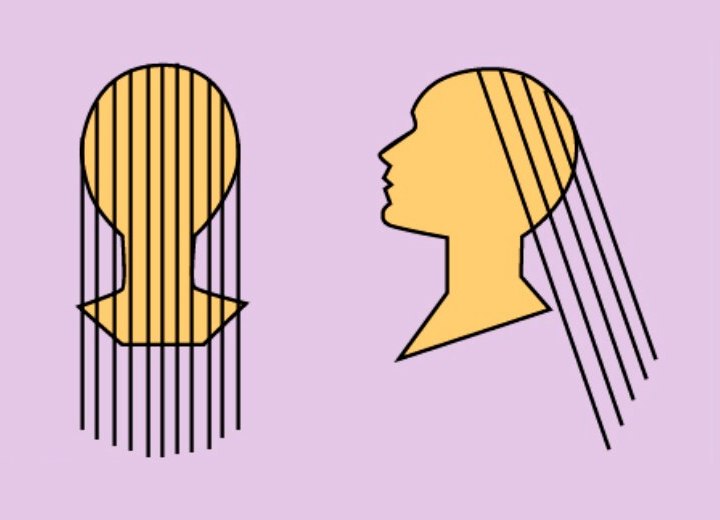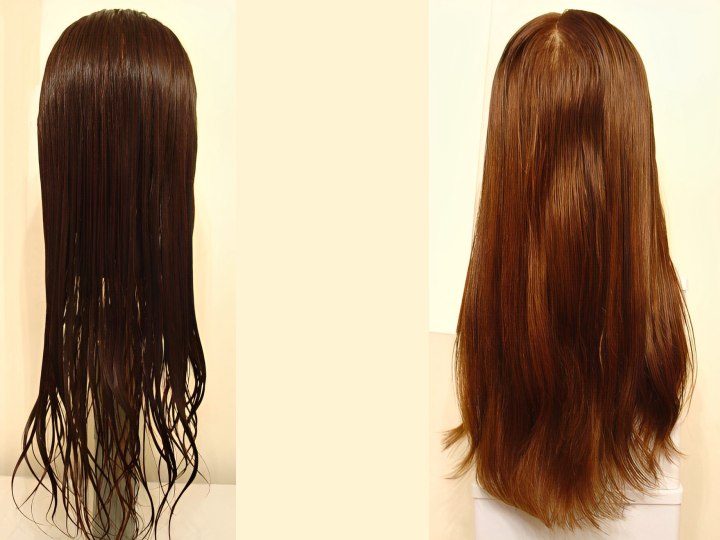Trimming Long Hair with Razored Ends

Recently I obtained a new manikin; specifically, a long-haired manikin. After she arrived, and I gave her a thorough shampoo and conditioning treatment, I examined her hair closely. The length was great, but the ends were a mess. They were uneven and very stringy-looking at the bottom. I knew she needed a trim.
However, the sight of the unevenness and stringy ends made me think of the issues common to women (and men) who are growing their hair long. Many people attempting to achieve long locks believe that cutting their hair, even slightly, is unacceptable. The truth is, a slight trim can make all the difference between hair that looks untidy and unhealthy and hair that you can take pride in.
I sectioned the manikin's hair into seven sections and gave her a blunt cut using a curved cutting line. Because of the disparity in length, I soon found no "extending hairs" to cut to the blunt line and was finished with the basic portion of the cut. During this process, I removed approximately two inches of length from the manikin's hair.
It is important to note that I didn't cut any bangs into this manikin, preferring to keep her hair all one length. I made certain that my lengths were even on each side by taking sections from the same places on each side and bringing them forward or back to meet in the center of the face or center back of the head. Uneven lengths would be obvious using this method.

Now, I had a manikin with hair that was fuller all along the length, but the individual hairs at the lower two to three inches were still uneven in density, so I decided to "balance" things out by using a straight razor to texturize the ends of the hair.
I started by re-misting the hair and combing it flat. Then beginning in the center back of the head, I combed out one-inch vertical segments which I then combed from the side until flat and held them with tension at a 15-degree elevation. At this point, I used the straight razor to "gently" shave the lower two inches of the segment at an inward angle. I carefully worked my way around the left side of the head before returning to the center back and work around to the right.
I double-checked my reference points as noted above to ensure evenness. Once assured of the evenness of the cut, I used a blow dryer with a diffusing attachment and a flat paddle brush to dry the hair to a mostly dry state. This keeps the hair smooth and flat without added styling.
I cannot emphasize enough to those of you who have long hair or are striving to grow your hair long that maintaining regular trims is crucial for maintaining its health and appearance. Daily styling, environmental factors, negligent brushing and combing, sleep, and accidents can all lead to hair breakage, resulting in unevenness and thin-looking ends.
Even if you are as careful as you can possibly be, and have no breakage, your hair does not grow evenly. Each individual hair follicle grows at it's own pace, and while most of the follicles may be growing at any given time, over the course of months, signs of unevenness will begin to show.
The key is to find a stylist whom you can trust to trim just enough to keep your hair looking healthy. Make sure to clearly communicate your desires and expectations to them. While there may be a few stylists who believe they know best and may attempt to exceed your boundaries, most of us aim to satisfy our clients and make them happy. Giving you a shorter cut than you wanted or expected is definitely not the way to achieve that goal.
©Hairfinder.com